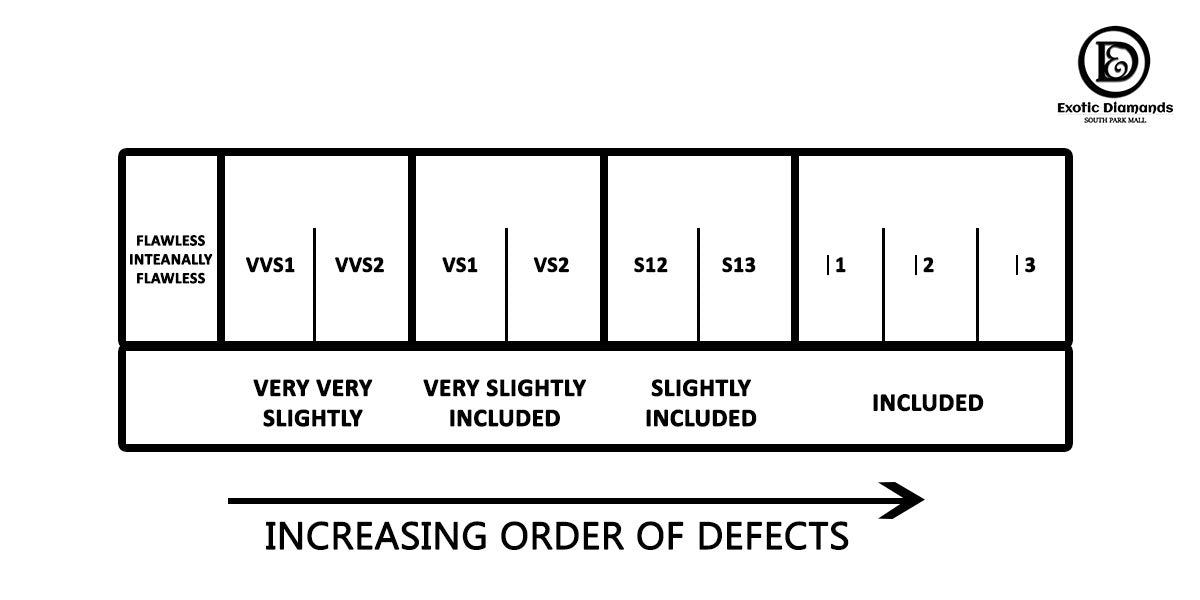Sep 09 , 2020
Diamond Clarity
DIAMOND CLARITY
Introduction
Diamond Clarity refers to the absence of characteristic imperfections found on
the surface and interior of a diamond. When found on the surface, these
imperfections are referred to as ‘blemishes’ while when found within the diamond
they are called ‘inclusions’. Usually, a diamond’s beauty is not compromised by
these tiny defects since most inclusions aren’t visible to the naked eye.
A diamond is formed deep within the Earth under tremendous pressure and heat
for billions of years. These flaws are inevitable.
Few pointers on Diamond Clarity
Did someone tell you to buy high clarity grade diamonds to avoid visible
imperfections or that higher clarity grade diamonds sparkle more? Unfortunately,
they weren’t right. Similarly, there are numerous misinterpretations regarding the
clarity of diamonds so it’s crucial to verify the credibility of your sources.
Following is a list of several valid facts about diamond clarity.
In the diamond industry, inclusions are often termed as “internal characteristics” since they are accountable for a diamond’s character.
The term “eye clean” is used to describe a diamond with too small inclusion, to be seen with the naked eye.
When searching for an ideal clarity grade for your budget, start with Slightly Included (SI) and Very Slightly Included (VSI) clarity grades. SI and VSI clarity grade diamonds require magnification for their inclusions to be seen.
Clarity of a diamond is affected by its shape and size. When buying a fancy-shaped diamond or a diamond over 1 carat, go for a higher clarity grade.
Being one of the 4Cs of a diamond, Clarity is also a price-determining factor of the diamond.
The Diamond Clarity Scale Comprises 6 Categories and 11 Diamond Clarity Grades
The Diamond Clarity Grading Scale set by the GIA (Gemological Institute of America) consists of six categories and eleven diamond clarity grades.
1) I1, I2, I3 Included Diamonds
I clarity diamonds have apparent inclusions which are visible to the
naked eye.
The diamond’s beauty may be compromised by such inclusions.
2) SI1, SI2 Slightly Included (SI) Diamonds
Inclusions are visible under 10x magnification
‘Eye clean’ SI diamonds are of the finest value.
SI2 inclusions may be visible to the naked eye if keenly observed especially from the side.
3) VS1, VS2 Very Slightly Included (VS) Diamonds
Small inclusions which are either hard (VS1) or relatively easy (VS2) to see under 10x magnification.
Great quality diamonds
4) VVS1, VVS2, Very, Very, Slightly Included (VVS) Diamonds
Microscopic inclusions which are tough to see under 10x magnification.
Rare and Eye Clean diamonds
5) Internally Flawless (IF) Diamonds
Few blemishes may be visible if observed under a microscope.
Diamonds have no inclusions so the grade is depended on the surface blemishes.
Eye Clean
6) Flawless (FL) Diamonds
Absence of surface blemishes and internal inclusions
Extremely rare diamonds
Account for less than 1% of all diamonds
Factors Affecting the Diamond Clarity
Here is a list of five factors that affect the clarity of a diamond.
Size: The clarity grade of a diamond falls in the presence of bigger (easily detectable) characteristics.
Number: A small number of characteristics result in high clarity grade diamond.
Position: It refers to the location of a diamond’s characteristics. Inclusions present at the center of the table have a greater impact on the clarity of a diamond
Nature: It refers to the attributes of a diamond’s characteristics. Various types of inclusion may have a different effect on the clarity of the diamond.
Color and Relief: They are concerned with the visibility of a diamond characteristic as well as the contrast between the diamond characteristic and its surroundings.
The Perfect Diamond Clarity for Your Budget
The Flawless (FL) and Internally Flawless (IF) diamonds have the finest diamond clarity grade but are extremely rare. Hence, their prices can be a bit overwhelming. As an economical alternative, choose an eye clean diamond (a diamond with too small inclusions, to be seen with a naked eye) with a modest
clarity grade.
SI and VS clarity grade diamonds are ideal for such instances. They resemble higher clarity grade diamonds in looks (through naked eye) but are not too extravagant.
Diamond Shape
The ideal clarity grade of a diamond may vary with its shape. Emerald and Asscher- shaped diamonds are cut with rectangular facets which amplify the transparency of a diamond. This makes the internal inclusions of the diamond more apparent. Opt for a clarity grade of VS1 or higher to hide these inclusions.
On the contrary, round, princess, oval, marquise, pear, and heart-shaped diamonds are cut with brilliant facets which reflect light from numerous angles.
This naturally hides the inclusions of the diamonds so there’s no requirement for a high clarity grade.
Diamond Size
The size of a diamond’s facets increases with an increase in its diamond size.
This may also increase the visibility of the inclusions. Thus, go for a higher
quality grade for bigger diamonds.
The Clarity Plot of a Diamond
A clarity plot is a map of the clarity characteristics of a diamond. It locates the
external blemishes on the surface as well as the internal inclusions within the
interior of the diamond. The internal inclusions of a diamond are discerned
through an instrument with 10x magnification by a certified diamond grader.
The GIA Grading Report Gives You a Detailed
Overview of All the Characteristics of the Diamond
The GIA Grading Report provides you complete information regarding all the
characteristics of a diamond. It even includes those characteristics which are
overlooked while assigning a diamond’s grade. Moreover, the report also
integrates a clarity plot when the diamond is over 1 carat.
Different Types of Diamond Characteristics (Blemishes/Inclusions)
There are a multitude of diamond characteristics found in a diamond.
Types of Inclusions
Clouds
Feathers
Crystals or minerals
Knots
Cavities
Cleavage
Internal graining
Pinpoint
Knot










